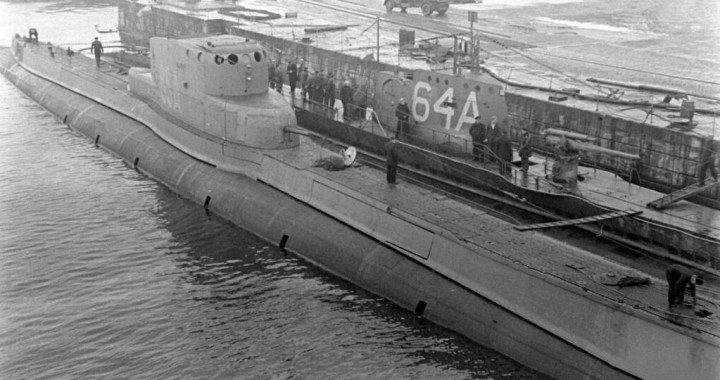1935
June 21st
The Board of the Naval Defense Funds submits to the Government of the Republic of Poland an amount of PLN 2,902,879.41 and requests the expenditure for the construction of the submarine.
November
Negotiations are underway for the order of the submarine in the Netherlands.
1936
January 29th
On behalf of the Government of the Republic of Poland, Rear Admiral Jerzy Swirski signs a contract for the construction of two submarines with Koninklijke Maatschappij “de Schelde” in Hague.
August 14th
Placement of the keel for a new Polish submarine on the ramp in Vlissingen.
1937
March 30th
Completion of shipboard framing.
May 14th
Completion of hull breach lying.
October 29 – November 2
Assembly of main electric motors on the ship.
1938
January 15th
Baptism and launching of the ship. The godmother of the ship is Jadwiga Sosnkowska. During the launching ceremony, the ship receives the name ‘Orzel’ (Orzel).
April 7 – June 3
Assembly of batteries.
May 3 – June 2
Assembly of diesel engines.
June 25 – July 18
First docking of the ‘Orzel’.
August 23rd
First exit of the ‘Orzel’ into the sea in the Delta Skalda.
September 30 – October 14
The second docking of the ship.
October 21st – November 1st
‘Orzel’ passes torpedo test at Den Helder.
November 12 – December 2
Speed and immersion tests.
1939
January 20th
She leaves dock.
February 2
A ceremonial raising of the Polish flag on a ship.
February 5
‘Orzel’ leaves Vlissingen and go to Poland.
February 7th
Arrival of a ship to Gdynia-Oksywia.
February 10th
Official welcome of the ‘Orzel’ in the Presidential Quay in Gdynia.
1st of June
Captain Jan Grudzinski becomes deputy commander of the ship.
June – August
‘Orzel’ runs patrol cruises.
July 17th
‘Orzel’ becomes the flag ship of the squadron commander.
1939
September 1st
‘Orzel’ leaves the port of Gdynia at 06:30 and goes to the area of her sector.
September 2nd
The ‘Orzel’s crew is witnessing the bombing of Gdynia and the Hel Peninsula.
September 3
According to commander of the ship, from 2 a.m. to 6 a.m. she lies at the bottom, at a depth of 15-16m. Then she patrols in the vicinity of Hel. According to the second scenario, ‘Orzel’ spent most of the day at the bottom, emerging at dusk. At 22:00, during a direct naval meeting, an information is exchanged with commander of ORP “Wilk”.
September 4
The ‘Orzel’ leaves the designated sector and goes to Gotland.
September 5
The crew is carrying out repair work on damaged ballast tanks.
September 6
Supervision along the coast of Gotland. Detection of unarmed ship “Bergen” or “Bremen.
September 7th
She conducts a patrol between Gotland and Estonia. ‘Orzel’ connects with ‘SEP’ through the radio.
September 8th
Health worsening of the ship’s commander.
8-12 September
According to the commander of the ‘Orzel’, she was carrying out the patrol in the Brüsterort Cape where she arrived at the break of dawn on September 8. According to the second scenario, the ship was between Gotland and Estonia. On September 10, the ‘Orzel’ sends a report to the commander about the Squadron Captain’s disease, which prevents him from commanding the ship. In response, the fleet commander recommends to dropp the captain off in a neutral port and act under the command of his deputy or approach to Hel to replace the commander. Second Lieutenant Commander H. Kłoczkowski decides to call at Tallinn.
September 13th
Health worsening of the ship’s commander. The ship goes to a distant Tallin.
September 14th
At about 21:30 ‘Orzel’ enters the Tallinn’ stead near the Paljassar peninsula.
September 15th
From 1:00 to 3:00 am, another Estonian officer arrives aboard the submarine, who is informed of the compressor failure and the disease of the commander. The Estonian side informs that the German merchant vessel Thalatta is staying in port and that, in accordance with the international law, she will be leaving the port as a first and that the ‘Orzel’ will not be able to leave Tallinn sooner than 24 hours after Thalatta’s departure from the port. Lieutenant Commander H. Kłoczkowski goes to the hospital. In the afternoon, the ‘Orzel’ is interned and deprived of the logbook and maps.
September 16-17
Disassembly and confiscation of ship’s armament, firearms, artillery ammunition, locks and fourteen out of twenty torpedoes.
September 18th
At. 03.00 the ship’s crew disables two Estonian sailors, cuts telephone, electrical cables and hawsers, and ‘Orzel’ starts the maneuver of the departure from the port. During these maneuvers, the ship enters the bow at the underwater pier and temporarily becomes immobilized. Estonians open fire from machine guns and coastal artillery. ‘Orzel’ descends from the underwater obstacle and leaves the port. The ship’s commander informs Hel with an open text about the escape and lack of cipher and maps.
September 19th
‘Orzel’ receives a radio message about her escape and information of German propaganda regarding the accusation of the crew for the murder of two Estonian guards. On board, navigator second lieutenant Mokrski draws handwritten maps of the Baltic and Danish Straits on the basis of the old lighthouse inventory.
September 21st
She arrived near Gotland, where two Estonian sailors were dropped off.
September 30th
‘Orzel’ is heading to the region of Öland island.
1-6 October
She attempts to torpedo the German ship and enters the shoal. While descending from it, she is attacked by a German seaplane.
October 7th
The ship’s commander decides to cross to England.
October 8th
She goes to Falsterbov cape. Then on the middle branch of Sundu to Drogden Canal, where she meets the patrols of Swedish and German ships.
October 9th
The ship passes by Helsingor and Hälsingborg.
October 10th
‘Orzel’ enters Kattegat waters.
October 11th
The ship enters the Skagerraku water.
October 12th
‘Orzel’ heads to the shores of England through the waters of the North Sea.
October 14th
A distinctive signal and position were given from the ship at 06:00. Five hours later at a distance of 30 Mm from the Isle of May ‘Orzel’ meets the British destroyer ‘Valorous’, which leads him to the port of Rosyth.
October 21st
The Chief of Naval Command, in daily Order No. 2a, expressed his highest appreciation to commander of the ORP Orzel – Jan Grudzinski, for all actions taken and praised the officers and crew of the ‘Orzel’.
October 30th
Passage of the ‘Orzel’ from Rosyth to Dundee where it is to be placed in one of the two dry docks at Caledon Shipbuilding & Engineering Company Ltd.
November 17
General Sikorski and Rear Admiral Swirski’s visit in Dundee, for a distinction of a part of ORP ‘Orzel’s crew.
December 1st
End of ship repair and transition to Rosyth. She is incorporated into the Second Flotilla and receives the 85-T tactical mark.
December 10th
Award of the Distinguished Service Order given to the Captain J. Grudzinski.
December 29 – January 1
‘Orzel’ takes part in the escort of a convoy from Lerwick in Shetland to Bergen.
January 1-4
The ‘Orzel’ along with other escort ships carried the convoy from Bergen to Firth of Forth.
January 18-27
‘Orzel’s first independent patrol
February 10-23
‘Orzel’s second standalone patrol
February 26th
Visit of King George VI in Rosyth, meeting and talks with captain J. Grudzinski.
March 5-17, 1940
The third independent patrol ‘Orzel’.
April 3-18, 1940
‘Orzel’s fourth individual patrol. April 8, scuttle of the ‘Rio de Janerio’.
April 28-May 11, 1940
‘Orzel’s fifth independent patrol.
May 23?
‘Orzel’s sixth individual patrol, during which she disappeared in unexplained circumstances.
June 12th
Navy Administration of Republic of Poland issued the following message:
Due to lack of information and no return from patrol within the deadline, the submarine ‘Orzel’ of the Republic of Poland should be considered lost.


